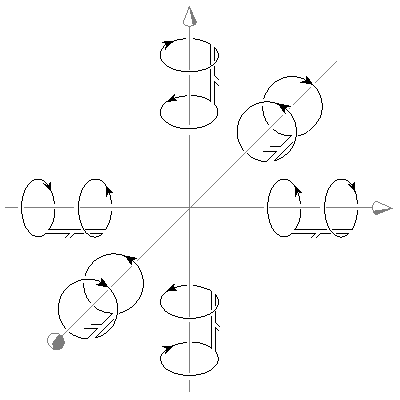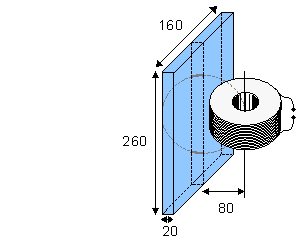 |
| By Geek3 [GFDL or CC-BY-SA-3.0], via Wikimedia Commons |
| This is an illustration of the magnetic field around a cylindrical magnet Note that there are two poles in stead of one. The magnet force lines are depicted as going from north to south in a circular pattern. |
|
|
|
|
 |
 |
| By Geek3 [GFDL or CC-BY-SA-3.0], via Wikimedia Commons |
By Geek3 [GFDL or CC-BY-SA-3.0], via Wikimedia Commons |
| This is an illustration of the magnetic field around antiparallel cylindrical magnets Note that each magnet has two poles in. The magnet force lines are depicted as going between the two magnets from a north pole to a south pole in a circular pattern As a result the two magnets are attracted to each other. |
This is an illustration of the magnetic field around parallel cylindrical magnets. Note that each magnet has two poles in. The magnet force lines are depicted as going from the North Pole to South Pole of each magnet in a circular pattern. However they are repelling the force lines of the other magnet. As a result the two magnets are repelling each other. |
|
|
|
|
 |
 |
| By Geek3 [GFDL or CC-BY-SA-3.0], via Wikimedia Commons |
By Geek3 [GFDL or CC-BY-SA-3.0], via Wikimedia Commons |
| This is an illustration of the magnetic field around two cylindrical magnets oriented end to end and North Pole to South Pole. Note that each magnet has two poles in it. The magnet force lines are depicted as going between the two magnets from a north pole to a south pole in a circular pattern. As a result the two magnets are attracted to each other. |
This is an illustration of the magnetic field around two cylindrical magnets oriented end to end and North Pole to North Pole. Note that each magnet has two poles in it. The magnet force lines are depicted as going from the North Pole to South Pole of each magnet in a circular pattern However they are repelling the force lines of the other magnet resulting in the two magnets are repelling each other. |
.jpg)











 Răspunde cu citat
Răspunde cu citat.jpg)









 The current induced in a conductor depends on the rate of change of the magnetic flux that links the current loop. In analogy to the electric field case (see Equations 11.30 and 11.52), the reciprocally energizing (time-varying) current Ir is normalized so that its time derivative is unityfor all values of ω. The necessary equations for the lead field theory for biomagnetic measurements can then be readily obtained from the corresponding equations in electric measurements.
The current induced in a conductor depends on the rate of change of the magnetic flux that links the current loop. In analogy to the electric field case (see Equations 11.30 and 11.52), the reciprocally energizing (time-varying) current Ir is normalized so that its time derivative is unityfor all values of ω. The necessary equations for the lead field theory for biomagnetic measurements can then be readily obtained from the corresponding equations in electric measurements. 
 LM
LM LM
LM LM
LM LM
LM






























Marcaje